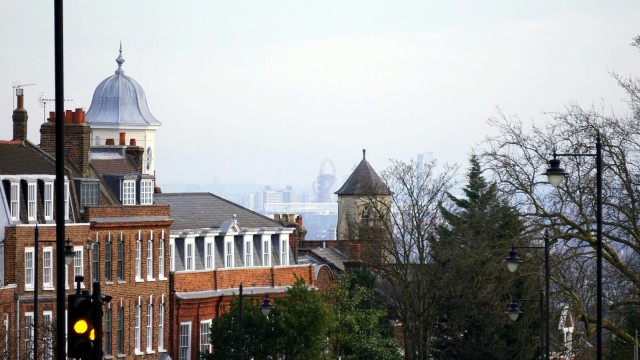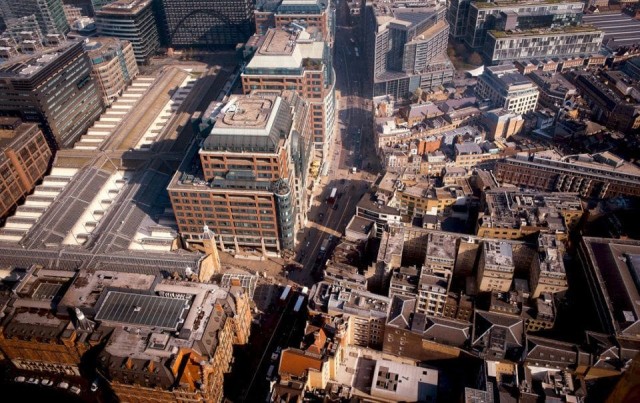Read next
The latest news, updates and expert views for ambitious, high-achieving and purpose-driven homeowners and property entrepreneurs.


Embarking on a new build or renovation project is always an exciting process, but there are also multiple challenges to overcome along the way.
Hiring the right chartered architect or a RIBA-chartered architecture practice can be one of the best decisions you make as a home or property owner. Not only can chartered architects bring innovative design ideas and creativity to your project, but they can also ensure that your vision comes to life in a cost-effective and timely manner.
In this article, we'll explore the advantages of hiring a chartered architect or a chartered architecture practice, and why they should be at the top of your list when it comes to selecting a project team.

Before we dive into the benefits of hiring a chartered architect, it's important to understand the role of architecture in construction projects. Architecture is the art and science of designing and creating buildings that are both functional and aesthetically pleasing. Architects combine their creativity and technical expertise to create spaces that meet the needs of the people who will use them.
Architecture is a crucial aspect of any construction project, whether it's a small residential home or a large commercial building. It involves a careful consideration of the site, the budget, the needs of the occupants and the surrounding environment. Architects work closely with clients to understand their vision and translate it into a functional and beautiful architectural design.
Good architecture has the power to transform the way people live and work. It can enhance the quality of life, improve productivity and promote sustainability. For example, a well-designed office space can boost employee morale and creativity, while a sustainable building can reduce energy consumption and lower operating costs.
Moreover, architecture is not just about creating buildings that look good. It's also about creating spaces that are safe, comfortable and accessible for everyone. Architects consider factors such as accessibility, safety codes, and environmental impact when designing a building.
Ultimately, architecture is about creating spaces that enrich people's lives. It's about creating buildings that are not just functional, but also beautiful and inspiring. Whether it's a home, a school, or a hospital, good architecture can make a real difference in people's lives.

The Royal Institute of British Architects (RIBA) is a professional body for architects primarily in the United Kingdom, but also internationally. It was originally established in 1834 for the advancement of architecture and granted a royal charter by King William IV three years later.
The Architects Registration Board (ARB) is the body established by the UK parliament to regulate the architects' profession in the UK. Its functions and responsibilities are set out in the Architects Act 1997. Only professionals registered with ARB are allowed to describe themselves as architects in the UK.

Membership in RIBA is a recognised mark of professional excellence and integrity in the field of architecture. With a RIBA-chartered architect, you can start a project in the knowledge that the people you are working with have the expertise and qualifications necessary to ensure that your project is a success.
From initial design to planning to construction, they can guide you through the entire process and help you avoid costly mistakes that could jeopardize the success of the project or even compromise its safety.

To become a RIBA-chartered practice, an architecture firm must meet the following criteria (these are quoted directly from RIBA documents):
1. The practice is a full-time architects' business, or, a definable architectural practice business unit within a multi-functional organisation, with responsibility to ensure all practice information submitted to RIBA is up to date and accurate.
2. At least one of the full-time principals (director or partner) in the architects' practice must be a chartered member of RIBA.
3. All architectural work must be under the personal supervision of a RIBA-chartered architect and arrangements in place to ensure work is covered in the event of their absence.
4. RIBA chartered practices must meet a quality assurance standard of staff bound by a relevant code of conduct. This is based on a minimum of 1:8 staff being chartered members of RIBA.
5. The practice and all employees must conduct themselves in accordance with the Code of Practice for Chartered Practices.
6. The practice must operate a management system to ensure that architects in this office adhere to the RIBA Code of Professional Conduct and comply with continuing professional development obligations.
7. The practice must hold professional indemnity insurance (PII) cover appropriate for the work undertaken by the practice, or an equivalent form of insurance if operating outside of the UK.
8. The practice must operate a quality management system, relevant to the size of the practice.
9. The practice must ensure that an appropriate health & safety policy is in place and operational.
10. The practice must ensure that an appropriate environmental management policy is in place and operational.
11. The practice must operate an employment policy that addresses the requirements of the RIBA Chartered Practice Employment Policy Guide.
12. The practice must ensure that an appropriate equality, diversity and inclusion policy is in place and operational.
13. The practice, if a business registered and located in the UK, is required to make a return of the annual RIBA Business Benchmarking Survey.

RIBA membership is a mark of quality and professionalism that benefits both the individual architect and the client. It ensures that your architects are up-to-date with the latest regulations as well as the best practices in the field of architecture, have access to a vast network of resources and are committed to ethical standards.
A significant advantage of hiring a chartered architect is that they can help you maximise your investment. By working within your budget, a chartered architect can ensure that your resources are used in the most efficient way possible. Not only will they be able to design a space that meets your specific needs, but they will also be able to advise on the most cost-effective materials to use, ensuring that you achieve the desired aesthetic without spending more than you need to.
RIBA-chartered architects have a wealth of knowledge and experience in building design and construction. They understand the intricacies involved in the building process and can provide advice on everything from materials used to lighting and acoustics. This level of attention to detail ensures that every aspect of your project is thoroughly planned and executed, resulting in a space that is both beautiful and functional.
Another advantage of hiring a RIBA-chartered architect is that they can manage the entire project on your behalf. They can help you appoint specialist consultants, select and manage contractors, negotiate contracts, and oversee the construction process. This can save you time and money while also ensuring that your project stays on track and consistent with your vision.
With a qualified and experienced RIBA-chartered architect at the helm, you can trust that your project is in safe hands. They will ensure that the project runs smoothly, is delivered on time and within budget, and that all works are carried out to the highest standard. This level of project management can be invaluable in ensuring that your project is a success.
Building a new development or renovating a property can be a stressful experience, particularly if you are unfamiliar with the process. By hiring a chartered architect, you can have peace of mind that your project is in safe hands. A chartered architect will take care of all aspects of the project, from design through to construction, ensuring that everything runs smoothly and that all works are carried out to the highest standard.
With a RIBA-chartered architect or RIBA-chartered architecture practice managing your project, you can relax and enjoy the process, safe in the knowledge that your investment is being maximised and that your project is in the best possible hands.
One of the most exciting aspects of working with an architect is their ability to unleash creativity and imagination. No two building projects are ever the same, and a chartered architect can help you create a space that is unique to you.
Qualified architects can deliver innovative architectural design ideas that meet your needs and exceed your expectations. They can take inspiration from anything from nature, to art, or emerging design trends, and will work with you to develop a vision that is tailor-made for your lifestyle, personality and taste. By working with a chartered architect, you can be sure that your project will be a true reflection of your individuality and creativity, resulting in a space that is both functional and beautiful.

One of the most challenging aspects of any building project is navigating the planning permission and building regulations process. This is where a chartered architect or chartered town planner can be invaluable, as they have the knowledge and experience necessary to navigate complex regulations and restrictions.
An experienced architectural and planning team can help to make the planning permission and building control processes as smooth as possible. They can work with the regulatory authorities to ensure that all necessary documentation is submitted and that the project meets all relevant statutory requirements.

When it comes to planning permission, it is important to understand that the process can be time-consuming and complicated. In the UK, for example, there are a number of planning considerations that can impact whether or not planning permission is granted, including the impact of the project on the local environment and community, as well as its compliance with local planning policies.
One of the key ways in which an architect can help you with planning applications is by creating detailed drawings and specifications. These documents are essential for demonstrating to the local planning authority that your proposed development is in line with planning policies and regulations. A RIBA-chartered architect can work with you to create accurate planning drawings that clearly show the proposed development and how it will fit into the surrounding area.
In addition to creating drawings and specifications, an architect can also help you to prepare other documentation that may be required as part of the planning application process. This could include reports on the impact of the proposed development on the local environment, such as a design & access statement, as well as assessments of the potential impact on traffic and other local infrastructure.
Perhaps one of the most significant benefits of working with an architect during the planning process is their ability to liaise with the local planning authority on your behalf. This can be a time-consuming and frustrating process, but a chartered architect can use their knowledge and expertise to ensure that your application is handled efficiently and effectively.

Building regulations and the building control process in the UK are designed to ensure that approved methods and materials are used in construction, and that all buildings are safe, energy-efficient and accessible for all occupants.
The regulations are constantly updated, and it is essential for anyone undertaking construction work to ensure they hire an experienced architect with the input of a structural engineer for building regulations approval.
It is worth noting that building regulations and compliance can be particularly challenging for projects that involve older buildings or buildings with unique features. These projects require a particularly high level of expertise and attention to detail in order to ensure that they comply with all relevant regulations and codes.
Your architects should prepare your building regulations application drawings based on technical legislation that is laid out in the Approved Documents. Designing your project to meet building regulations ensures that your building:

Embarking on a construction project can be an exciting yet daunting task. Choosing the right architect is crucial as they will be the ones responsible for turning your vision into a reality. Here are some factors to consider when selecting a chartered architect:
It's important to choose an architect with experience in the type of project you're planning. If you're building a commercial property, for example, you'll want an architect who has experience designing and building commercial spaces. Experience is a good indicator of an architect's ability to handle challenges that may arise during the project.
Check the architect's credentials to ensure that they are chartered members of RIBA. This will give you peace of mind knowing that they have the expertise to handle your project.
Every architect has their own design style. Take a look at their architectural portfolio to see if their style aligns with your vision for the project. You want to choose an architect who can bring your ideas to life while still incorporating their unique style.
Building a rapport with your architect is crucial as you'll be working closely with them throughout the project. It's important to choose someone who you feel comfortable communicating with and who understands your needs and preferences.
Make sure that your RIBA-chartered architect or RIBA-chartered architecture studio has adequate resources to manage and oversee your project. This includes having established relationships with other professionals you are likely to need in your building project, such as structural and M&E engineers. They are also likely to have worked with contractors that they can recommend. All of these will work together with your architect to ensure the project runs smoothly.

When it comes to building or renovating your home or business premises, hiring a RIBA-chartered architect or a RIBA-chartered practice can be a wise investment. A RIBA-chartered architecture company has the expertise and experience to provide a client-focused service that delivers practical and functional architectural design solutions, while at the same time creating a beautiful and visually appealing end result.
For example, at Urbanist Architecture, we work closely with our clients, and take the time to understand their requirements and aspirations. We use our technical knowledge and expertise to develop innovative solutions that meet their specific needs. From the initial concept stage through to the final stages of the project, we can act as an advisor, providing guidance and support throughout the entire process.
As chartered architects, we provide a range of architectural services on a project, including developing design concepts, obtaining approvals, coordinating construction works, managing costs and ensuring compliance with local regulations.
Our firm, Urbanist Architecture, is not a large architecture company. Our small team allows us to place a great emphasis on close-knit interaction with our clients. By choosing to work with a smaller clientele, we are able to commit ourselves to working alongside you, ensuring a meticulous eye for detail. This structure facilitates the delivery of high-quality results that are uniquely personalised to your specific requirements.
While hiring a chartered architect can be incredibly beneficial, it may not always be necessary for your project. Here are a couple of instances where you may want to consider alternatives:
If you have a limited budget and what you want to do is very straightforward in design terms, you could consider working with a design-build firm that can offer both design and construction services together, potentially saving some money on the design part. However, you should be aware that you might end up with something that doesn’t feel personal to you in any way. If that’s fine by you, this is a route that could work for you.
If you're planning a DIY project, such as a minor home decoration work, realistically, you wouldn’t need an architect to help you. However, it's still important to seek advice from a qualified professional to ensure that your project meets building regulations and is safe to carry out.
While these are all valid reasons to consider alternatives to hiring an architect, it's important to note that each project is unique. It's always worth seeking advice from a qualified professional to ensure that you make the right decision for your specific project.

As a RIBA-chartered architecture practice with residential architects, we prioritise finding the ideal balance between aesthetic appeal and functionality to ensure your project's success. Our approach to architectural design is far from superficial. We believe that the beauty of a space isn't just about its visual appeal - it's about how well it serves those who inhabit it.
Our architects are trained to consider the whole of a design. They focus on creating spaces that are not only attractive but also functional, accessible and sustainable. By choosing to collaborate with us, you can rest assured that your space will be a harmonious blend of beauty and practicality.
One of the key advantages of working with us is our commitment to creating a unified design plan. We understand that every element in a space contributes to the overall design, and we ensure that each component complements the others. We consider the architectural structure, the surrounding environment, and your individual style and preferences to create a comprehensive plan that resonates with your vision.
We also offer exclusive access to a broad range of materials and products that may not be available to the general public. We assist in selecting materials and finishes that are visually appealing and meet your functional needs.
Moreover, we excel in identifying and implementing creative solutions to design and planning challenges. Whether you're dealing with a small space or want to incorporate unique design elements, we have the expertise to guide you. We specialise in maximising space usage without compromising on functionality or style and can help make your space truly distinctive.
By choosing to work with us, you're opting for a range of significant benefits. From developing a cohesive design plan to finding innovative solutions to design challenges, we can help transform your space into something that's not only visually stunning but also exceptionally functional and practical.
In our move towards a sustainable future, we embrace the use of eco-friendly and recycled materials. We are constantly exploring innovative ways to incorporate these materials into our designs, thus creating structures that are as environmentally friendly as they are visually stunning.
We also keep a close eye on emerging trends, such as the integration of technology in architecture. With the advent of smart homes and the Internet of Things, we're incorporating advanced technology into our designs to create buildings that are not only efficient but also responsive to the needs of their inhabitants.
Furthermore, we believe in the power of art in architecture. This approach has given rise to a new form of architecture - one that focuses not just on the structure itself, but also on the experience it offers to its occupants.
If you are interested in working with us, please do get in touch today.

Urbanist Architecture’s founder and managing director, Ufuk Bahar BA(Hons), MA, takes personal charge of our larger projects, focusing particularly on Green Belt developments, new-build flats and housing, and high-end full refurbishments.
We look forward to learning how we can help you. Simply fill in the form below and someone on our team will respond to you at the earliest opportunity.
The latest news, updates and expert views for ambitious, high-achieving and purpose-driven homeowners and property entrepreneurs.
The latest news, updates and expert views for ambitious, high-achieving and purpose-driven homeowners and property entrepreneurs.










We specialise in crafting creative design and planning strategies to unlock the hidden potential of developments, secure planning permission and deliver imaginative projects on tricky sites
Write us a message